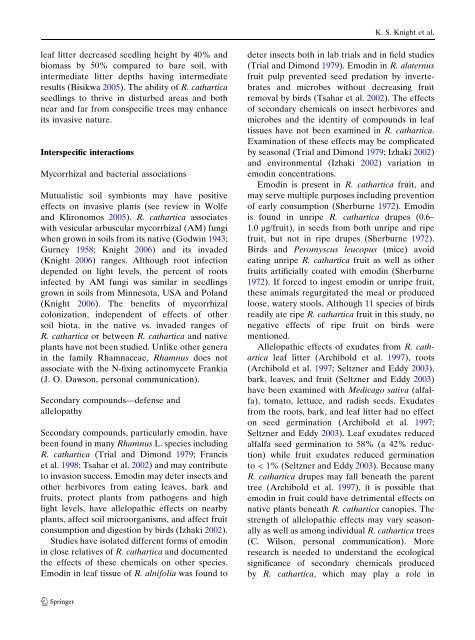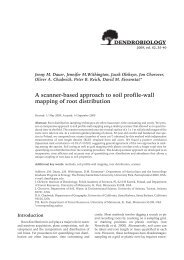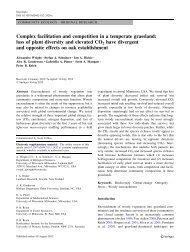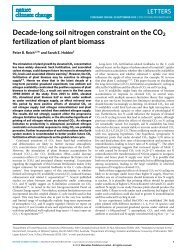Ecology and ecosystem impacts of Rhamnus cathartica
Ecology and ecosystem impacts of Rhamnus cathartica
Ecology and ecosystem impacts of Rhamnus cathartica
You also want an ePaper? Increase the reach of your titles
YUMPU automatically turns print PDFs into web optimized ePapers that Google loves.
leaf litter decreased seedling height by 40% <strong>and</strong><br />
biomass by 50% compared to bare soil, with<br />
intermediate litter depths having intermediate<br />
results (Bisikwa 2005). The ability <strong>of</strong> R. <strong>cathartica</strong><br />
seedlings to thrive in disturbed areas <strong>and</strong> both<br />
near <strong>and</strong> far from conspecific trees may enhance<br />
its invasive nature.<br />
Interspecific interactions<br />
Mycorrhizal <strong>and</strong> bacterial associations<br />
Mutualistic soil symbionts may have positive<br />
effects on invasive plants (see review in Wolfe<br />
<strong>and</strong> Klironomos 2005). R. <strong>cathartica</strong> associates<br />
with vesicular arbuscular mycorrhizal (AM) fungi<br />
when grown in soils from its native (Godwin 1943;<br />
Gurney 1958; Knight 2006) <strong>and</strong> its invaded<br />
(Knight 2006) ranges. Although root infection<br />
depended on light levels, the percent <strong>of</strong> roots<br />
infected by AM fungi was similar in seedlings<br />
grown in soils from Minnesota, USA <strong>and</strong> Pol<strong>and</strong><br />
(Knight 2006). The benefits <strong>of</strong> mycorrhizal<br />
colonization, independent <strong>of</strong> effects <strong>of</strong> other<br />
soil biota, in the native vs. invaded ranges <strong>of</strong><br />
R. <strong>cathartica</strong> or between R. <strong>cathartica</strong> <strong>and</strong> native<br />
plants have not been studied. Unlike other genera<br />
in the family Rhamnaceae, <strong>Rhamnus</strong> does not<br />
associate with the N-fixing actinomycete Frankia<br />
(J. O. Dawson, personal communication).<br />
Secondary compounds—defense <strong>and</strong><br />
allelopathy<br />
Secondary compounds, particularly emodin, have<br />
been found in many <strong>Rhamnus</strong> L. species including<br />
R. <strong>cathartica</strong> (Trial <strong>and</strong> Dimond 1979; Francis<br />
et al. 1998; Tsahar et al. 2002) <strong>and</strong> may contribute<br />
to invasion success. Emodin may deter insects <strong>and</strong><br />
other herbivores from eating leaves, bark <strong>and</strong><br />
fruits, protect plants from pathogens <strong>and</strong> high<br />
light levels, have allelopathic effects on nearby<br />
plants, affect soil microorganisms, <strong>and</strong> affect fruit<br />
consumption <strong>and</strong> digestion by birds (Izhaki 2002).<br />
Studies have isolated different forms <strong>of</strong> emodin<br />
in close relatives <strong>of</strong> R. <strong>cathartica</strong> <strong>and</strong> documented<br />
the effects <strong>of</strong> these chemicals on other species.<br />
Emodin in leaf tissue <strong>of</strong> R. alnifolia was found to<br />
123<br />
K. S. Knight et al.<br />
deter insects both in lab trials <strong>and</strong> in field studies<br />
(Trial <strong>and</strong> Dimond 1979). Emodin in R. alaternus<br />
fruit pulp prevented seed predation by invertebrates<br />
<strong>and</strong> microbes without decreasing fruit<br />
removal by birds (Tsahar et al. 2002). The effects<br />
<strong>of</strong> secondary chemicals on insect herbivores <strong>and</strong><br />
microbes <strong>and</strong> the identity <strong>of</strong> compounds in leaf<br />
tissues have not been examined in R. <strong>cathartica</strong>.<br />
Examination <strong>of</strong> these effects may be complicated<br />
by seasonal (Trial <strong>and</strong> Dimond 1979; Izhaki 2002)<br />
<strong>and</strong> environmental (Izhaki 2002) variation in<br />
emodin concentrations.<br />
Emodin is present in R. <strong>cathartica</strong> fruit, <strong>and</strong><br />
may serve multiple purposes including prevention<br />
<strong>of</strong> early consumption (Sherburne 1972). Emodin<br />
is found in unripe R. <strong>cathartica</strong> drupes (0.6–<br />
1.0 lg/fruit), in seeds from both unripe <strong>and</strong> ripe<br />
fruit, but not in ripe drupes (Sherburne 1972).<br />
Birds <strong>and</strong> Peromyscus leucopus (mice) avoid<br />
eating unripe R. <strong>cathartica</strong> fruit as well as other<br />
fruits artificially coated with emodin (Sherburne<br />
1972). If forced to ingest emodin or unripe fruit,<br />
these animals regurgitated the meal or produced<br />
loose, watery stools. Although 11 species <strong>of</strong> birds<br />
readily ate ripe R. <strong>cathartica</strong> fruit in this study, no<br />
negative effects <strong>of</strong> ripe fruit on birds were<br />
mentioned.<br />
Allelopathic effects <strong>of</strong> exudates from R. <strong>cathartica</strong><br />
leaf litter (Archibold et al. 1997), roots<br />
(Archibold et al. 1997; Seltzner <strong>and</strong> Eddy 2003),<br />
bark, leaves, <strong>and</strong> fruit (Seltzner <strong>and</strong> Eddy 2003)<br />
have been examined with Medicago sativa (alfalfa),<br />
tomato, lettuce, <strong>and</strong> radish seeds. Exudates<br />
from the roots, bark, <strong>and</strong> leaf litter had no effect<br />
on seed germination (Archibold et al. 1997;<br />
Seltzner <strong>and</strong> Eddy 2003). Leaf exudates reduced<br />
alfalfa seed germination to 58% (a 42% reduction)<br />
while fruit exudates reduced germination<br />
to < 1% (Seltzner <strong>and</strong> Eddy 2003). Because many<br />
R. <strong>cathartica</strong> drupes may fall beneath the parent<br />
tree (Archibold et al. 1997), it is possible that<br />
emodin in fruit could have detrimental effects on<br />
native plants beneath R. <strong>cathartica</strong> canopies. The<br />
strength <strong>of</strong> allelopathic effects may vary seasonally<br />
as well as among individual R. <strong>cathartica</strong> trees<br />
(C. Wilson, personal communication). More<br />
research is needed to underst<strong>and</strong> the ecological<br />
significance <strong>of</strong> secondary chemicals produced<br />
by R. <strong>cathartica</strong>, which may play a role in






